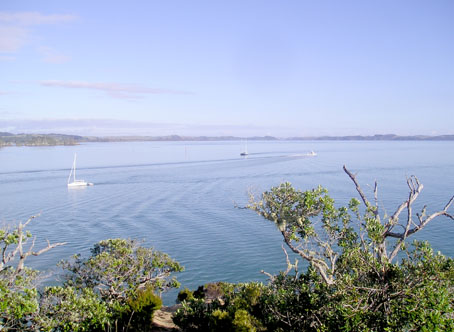|
|
|
|
|
|
|
|
|
|

|

|

|

|
Walks | Near RussellOkiato-Russell | Tapeka Beach
Te Wahapu Point and Tore Tore Island

Tore Tore
Island lies off the end of Te Wahapu peninsula separated
by a shallow stony passage that is dry at low tide. There
is a pleasant walk from a small reserve at the end of the
road along the southern shore to the Point.
On the island itself a path leads from the sign shown at
left through the forest to an elevated lookout at the far
end of the island which offers views across to Paihia and
up and down the channel leading from the open sea to
Opua.
|

Location,
Grade and Duration
At the far
end of Te Wahapu peninsula the road drops down to a small
parking area and reserve on the southern shore.
A pleasant walk westward along the stony beach gives
views of the sheltered inlet, a little cottage and
several bigger houses before another small reserve at the
end of the peninsula.
After crossing the channel at low tide a track winds up
through the small forest on Tore Tore Island finishing at
a lookout point on the western tip.
Depending on the tide, alternative walks can be chosen
around the several shore lines.
|

Restrictions
Access to
Tore Tore Island is tidal. The tidal range in the Bay is
moderate - about two metres - but use common sense to
avoid an unwanted swim. Russell tide forecasts are
available here: Russell Tides
There are no toilets or any kind of facilities or shops
on or near this walk.
The foreshore is mainly unfenced so dogs must be
controlled to ensure they don't trespass onto private
properties on the peninsula.
|

Interests
Swimming,
fishing, boating, sunbathing, strolling and
photography.
The historic Mair settlement site is signposted in a
small reserve at the end of the peninsula.
The bays around the north-east side of Te Wahapu peninsula from Toretore Island
were named Te Wahapu Beach, Elephant's Head, Maori Chief and The Mint in that
order. Elephant's Head got its name from its shape with three little islands
forming its "trunk". Maori Chief was an ex-steamer from Thames which was moored
in Pomare Bay and used as the engine of a mining bucket chain for the manganese
mine on Mt Tikitikioure.
Mint Bay was named from an old yarn: When the Army was barracked at Te Wahapu,
the coastal ship bring their pay anchored in Pomare Bay instead of Te Wahapu. While
transferring the strongbox full of gold sovereigns, the box slipped and fell,
hitting the gunwhale, bursting the lock and showering the pay into the shallows.
No-one knows now how much was retrieved but we can imagine the diving that went on
around the ship!
|

History
From 1830 the
end of Te Wahapu peninsula was the home of Gilbert Mair,
a young Scotsman: not only his home but a trading post,
workers' shops and cottages and wharf. He assembled a
team of carpenters, cobblers, shipwrights and other
tradesmen and the community flourished. It even had its
own schoolmaster and mail station! Gilbert and Elizabeth
Mair's home stood above the beach at the end of the
peninsula - and you can still see today a Norfolk Pine
said to have been planted by Elizabeth - one of the
oldest exotic trees in New Zealand. When mail arrived
from overseas, a flag would be flown from a flagstaff on
the point, and settlers starved for news from home would
row in from all over the Bay.
Tore Tore Island - or Nobby - was part of Gilbert
Mair's land purchase, but was not recognised by the
government and he was told that the government wanted it
for a naval base. This never came to anything. It is
believed Gilbert's sons named the island Nobby.
An old sketch shows it having two buildings - one on the
heights and one on the flat land above the beach. The
latter was the fever hospital and the one at the
summit an officer's home. When Mair moved to Whangarei
the property was requisitioned by the Army at about the
time of Heke's War. The Army occupied the buildings for
eleven years until 1857. The buildings remained empty
until 1865-66 when settlers from ships Mary Shepherd, the
Dauntless and the Lancashire Witch settled there, waiting
for their land at Whangae to be made available. They were
referred to as the Whangae migration. In the 1870s
scrub fires destroyed all the buildings.
One of the first and finest of NZ's early shipyards was
also in the area. Lane & Brown were famous for
repairs to whalers. When Lane left to set up on his own
at Totara North, William Paine Brown continued at Te
Wahapu.
|
Walks | Near RussellOkiato-Russell | Tapeka Beach
|

|

|

|

|
|
|
|
|
|
|